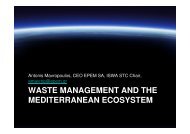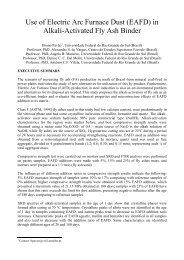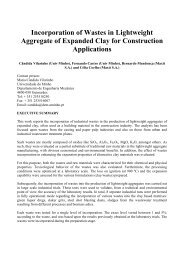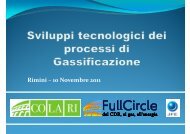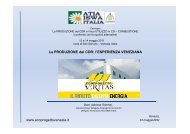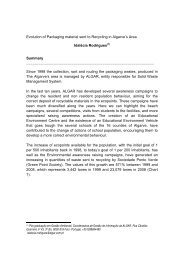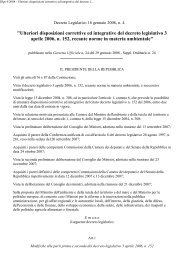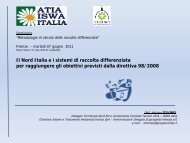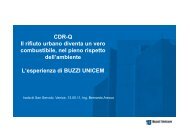Enhanced Plastics Recycling by Cyclone Media Separation - ISWA
Enhanced Plastics Recycling by Cyclone Media Separation - ISWA
Enhanced Plastics Recycling by Cyclone Media Separation - ISWA
You also want an ePaper? Increase the reach of your titles
YUMPU automatically turns print PDFs into web optimized ePapers that Google loves.
<strong>Enhanced</strong> <strong>Plastics</strong> <strong>Recycling</strong> <strong>by</strong> <strong>Cyclone</strong><br />
<strong>Media</strong> <strong>Separation</strong><br />
Malcolm R. Gent, Mario Menéndez, Javier Toraño, and Susana Torno, E.T.S.I.M.O.,<br />
University of Oviedo<br />
CONTACT<br />
Contact: Malcolm R. Gent<br />
Organization: E.T.S.I.M.O., University of Oviedo<br />
Postal Address: C/Independencia 13, 33004 Oviedo, Spain<br />
Telephone: (34) 985 10 42 59<br />
Facsimile: (34) 985 10 42 42<br />
Email: gentmalcolm@uniovi.es<br />
EXECUTIVE SUMMARY<br />
The combustion of certain types of plastics to reduce the high volumes of plastics in wastes and<br />
recovering energy entails potential environmental risks of producing toxic or carcinogenic gases.<br />
Recovery of plastics as a manufacturing feedstock is proposed as an optimum solution. Due to there<br />
being a vast range of types of plastics, many with very similar physical properties, their material<br />
recycling frequently requires the application of a combination of processing methods to optimize<br />
product purity and market value.<br />
Virtually all automated industrial plastics recycling processes use density separation methods as a<br />
preparatory cleaning and/or pre-concentration phase for subsequent processing methods, or in some<br />
instances, to produce a marketable product. Commercial applications are usually restricted to<br />
particles of 6.4 to 10 mm and throughput tonnage is limited due to rates of separation. With 24% to<br />
69% <strong>by</strong> weight of ASR being 90% purity and 100% recovery. Reprocessing the low-density product produced a<br />
low-density product with 99.95% purity and 99.26% recovery.
It is shown that feeding a low-density product of a cylindrical DMS cyclone along with the<br />
separation media into a second DMS cyclone and re-circulating the intermediate-density product of<br />
the latter with new feed material into the first can optimize product purities of both density fractions<br />
to >99.98% and attain 100% recoveries.<br />
Industrial scale versions of cyclone density media separators are interpreted as suitable for<br />
processing >0.5 mm to 120mm plastic wastes to produce high purity density separation products.<br />
Operating costs are interpreted to be significantly lower than established plastic density separation<br />
processes but require a large scale of operation is indicated.<br />
INTRODUCTION<br />
Reduction of the high volumes of plastics in wastes presents a challenge for the effective<br />
management and reduction of plastic wastes destined to landfills. The combustion of several types<br />
of plastics as a means of recovering energy, especially those containing halogens, includes the<br />
potential environmental risks of producing toxic or carcinogenic gases. Being a product derived<br />
from petroleum or gas, they have a potential market value considerably higher than that of fossil<br />
fuels with their recovery and separation for reuse as a manufacturing feedstock representing a<br />
substantial economic advantage over all other solutions.<br />
<strong>Recycling</strong> of plastics into commercial products <strong>by</strong> low cost methods such as those based on<br />
physical properties is complicated <strong>by</strong> the vast range of different types of plastics presently in use<br />
and new types are being continually developed. Since many having very similar physical properties,<br />
a combination of separation processes is frequently required. Such separations can be problematic<br />
as the high purity of recycled products generated is an essential parameter for their use and<br />
determines market value. Effective separations are best accomplished when a separation is limited<br />
to the wastes corresponding to individual product types or manufacturing sectors or even sections of<br />
these as the variety of plastics present is generally limited to only a few types. However, the plastic<br />
wastes produced in some sectors such as those corresponding to municipal solid wastes (MSW),<br />
automotive shredder residue (ASR), and waste electronic and electrical equipment (WEEE) are<br />
especially complicated due to the range in physical dimensions, types of plastics present and the<br />
historical as well as sociological evolution in types used.<br />
In the cases of ASR and WEEE, the recovery of plastics is becoming especially complicated <strong>by</strong> the<br />
ever-increasing variety of plastics and fillers that are being developed, many of which are<br />
thermosets that are incompatible with the re-useable thermoplastics. The increasing complexity<br />
resulting from the technological development of plastics is demonstrated <strong>by</strong> the evolution of<br />
electrical cable insulation or sheath compositions (Table 1) which constitute part of these wastes. A<br />
search of the literature (e.g. Globalspec, (2009) and Technocables, (2009) as well as consultation of<br />
electrical cable experts (Hodge, J., 2009, personal communication, BASEC) indicates that since the<br />
1960/80s there has been a vast increase in types of materials used for these applications.<br />
Present automated sorting, flotation, triboelectric, differential fragmentation, density and solvent<br />
extraction recycling methods being developed are effective and can generate products with<br />
properties matching or approximating those of virgin materials but have limited throughput<br />
capacities, require feeds with a limited range of types of plastics and a high content of marketable<br />
plastics to be economically viable. As the lowest cost recycling process, density separation methods<br />
are presently used in virtually all the automated industrial plastics recycling processes as a cleaning<br />
and/or pre-concentration and/or preparation phase for subsequent processing methods, or in some<br />
instances, to produce a marketable product.
Density separation<br />
methods presently used<br />
for recycling plastics<br />
are based on particles of<br />
plastics floating or<br />
sinking in a separation<br />
media of a given<br />
density, usually under<br />
the force of gravity.<br />
Since the process uses a<br />
feed with a lamellar<br />
displacement of the<br />
separation media,<br />
production capacities<br />
are limited due to:<br />
equipment limitations<br />
of maximum particle<br />
sizes; liberation size of<br />
different materials<br />
present; and especially<br />
the low rates of<br />
separations of smaller<br />
particles. Commercial<br />
operations are usually<br />
for 6.4 to 10 mm<br />
particles (Jody and<br />
Daniels, 2006) and as<br />
such, throughput<br />
tonnage and particle<br />
size capacity is limited<br />
Table 1: Comparison in none metallic materials and their densities used for<br />
sheaths and insulation in electrical cable from the 1960s-80s and the present<br />
Plastic type<br />
Materials<br />
used in the<br />
1960s-80s<br />
Materials<br />
used at<br />
present<br />
Range in<br />
densities<br />
(g cc -1 )<br />
Typical<br />
density<br />
(g cc -1 )<br />
Polyethylene foam X X 0.03-0.30 0.2<br />
Ethylene propylene diene M-class rubber X 0.86-0.95 0.88<br />
Paper X X 0.69-0.83 0.80<br />
Very low density polyethylene X 0.880-0.916 0.905<br />
Cross linked polyethylene X 0.920-0.945 0.935<br />
Low density polyethylene X X 0.918-0.93 0.932<br />
Medium density polyethylene X X 0.926-0.940 0.935<br />
High density polyethylene X X 0.941-0.965 0.94<br />
Polystyrene X X 1.03-1.07 1.06<br />
Polyamide (6, 66 & 11) X 1.06-1.16 1.14<br />
Cross-linked polyethylene X 1.15-1.28 1.15<br />
Chlorinated polyethylene X 1.09-1.25 1.16<br />
Polyurethane X X 0.4-1.2 1.20<br />
Polychloroprene rubber X 1.23-1.5 1.32<br />
Silicone rubber X 1.25-1.50 1.30<br />
Polyvinyl chloride X X 1.37-1.42 1.39<br />
Polyethylene terephthalate X 1.35-1.40 1.37<br />
Ethylene-vinyl-acetate X 0.927-1.97 1.40<br />
Ethylene-propylene rubber X 1.2-1.47 1.4<br />
Polyoxymethylene X 1.41-1.42 1.42<br />
Chloroprene rubber X ≈1.47 ≈1.47<br />
Ethylene vinyl-acetate X ≈1.49 ≈1.49<br />
Mica tape X X ≈1.5 ≈1.5<br />
Nitrile butane/Acrylonitrile-butadiene rubber X ≈1.5 ≈1.5<br />
Polychloroprene X ≈1.55 1.55<br />
Styrene-butadiene rubber X 1.45-1.70 1.6<br />
Rubber X X 1.52-≈1.6 1.6<br />
Chlorosulfonated polyethylene X 1.64 1.64<br />
Ethylene tetrafluoroethylene X ≈1.74 1.70<br />
Fluorine-ethylene-propylene X ≈2.15 ≈2.15<br />
Polytetrafluoroethylene X 2.07-2.20 2.17<br />
to
value; tend to have more acicular, platy or lath like forms; and density separations must be near<br />
perfect so as to optimize product purity. Results of tests conducted to evaluate the application of<br />
DMS cyclones for recycling plastics are presented here.<br />
TESTING OF A DMS CYCLONE FOR THE RECOVERY OF PLASTICS<br />
There are a number of different types of DMS cyclones, with the most common having a<br />
conocylindrical form (Figure 1a) identical to hydrocyclones but oriented at ≈30º from the<br />
horizontal. A cylindrical type (Figure 1b) was selected for this study due to it not requiring the<br />
particles to be treated passing through the pumping circuit and it producing a lower media density<br />
offset due to the lower media pressures used. Of this type of separator, the LARCODEMS was<br />
selected as the manufacturers specifications and reported industrial operations (McCulloch and<br />
Baillie, 1998 and Baillie et al., 1997) report it to be able to process the widest range of particle sizes<br />
(0.5 to 120 mm) and with low Ecart Probable (half the difference in densities where there are 25%<br />
and 75% probabilities of a particles of those densities report to a low or high-density product<br />
fraction) values of 0.006 to 0.044.<br />
Figure 1: <strong>Media</strong> separation flow paths in conocylindrical (A) and cylindrical (B) type DMS cyclones (modified<br />
after Gent et al., 2009a, b)<br />
Factors of primary importance in evaluating the possible application of DMS cyclone density<br />
separation of plastics for industrial scale applications include: the range of particles that might be<br />
treated collectively; the quality of the separations obtained; the physical-chemical (hydroscopic)<br />
effects of plastics; the separation media characteristics; and the devices configuration. The tests<br />
conducted were designed to evaluate both the use of a low cost suspended particle media typically<br />
used as fillers in plastics and to ascertain the effectiveness (purity and recovery) of separations of<br />
waste plastics <strong>by</strong> density and particle form. Due to the environmental and technical complexities<br />
involved using chemical solutions as the separation media in industrial recycling, a ground mineral<br />
typically used as fillers in plastics was selected to create a suspension in water for use as the<br />
separation media. Ground calcite was selected but other low cost minerals such as feldspar, barite,<br />
quartz, magnesite or magnetite could be used.<br />
Description of the LARCODEMS<br />
Although designed for treating coal, the LARCODEMS has also been proven suitable for treating<br />
iron ore. It is presently supplied in six versions with manufacturers recommended processing<br />
capacities and maximum particle sizes varying in proportion with the cylinder diameter of the<br />
devices. All have an excessive capacity for laboratory scale tests, with the smallest (300 mm<br />
diameter) having a calculated 9 t h -1 plastics capacity. A demonstration model with an ≈125 kg h -1
capacity was selected for these tests despite it not including some of the standard operating design<br />
characteristics nor necessarily conforming exactly to the proportions of the industrial versions.<br />
The device consists of a cylindrical separating chamber inclined at 30º from the horizontal. The<br />
separating media is injected tangentially at the lower end, forming a vortex with a central air core.<br />
Dry or moist material to be separated is fed at the top end to flow into the vortex. Dense fragments<br />
must settle through the ascending separating media circulating around the inner circumference of<br />
the cylinder to exit through the upper port (underflow) while the lower density material floats down<br />
the surface of the vortex to exit at the lower port (overflow). Analysis of the manufacturers<br />
recommended operating specifications for processing coal show that there is an exponential<br />
relationship between the maximum plastics processing capacity (y c ) in kg h -1 (Equation 1) and<br />
maximum treatable particle size (y s ) in mm (Equation 2) relative to cylinder diameter (x) in mm.<br />
These equations fit the data with correlation coefficients (R 2 ) of 0.9938 and 0.9926 respectively. As<br />
such, any increase in separation cylinder diameter has a substantial effect on both throughput<br />
capacity and maximum size of particles that may be processed.<br />
Eq 1 y c = 0.00009x 2.0869<br />
Eq 2 y s = (0.000006x 2 ) – (0.0734x) + 6.9574<br />
0.1<br />
0.09<br />
0.08<br />
0.07<br />
0.06<br />
0.05<br />
0.04<br />
0.03<br />
0.02<br />
0.01<br />
0<br />
1.3 1.4 1.5 1.6 1.7 1.8 1.9<br />
Density (g/cc)<br />
Analysis of results (Baillie et al,<br />
1997) from industrial coal<br />
processing tests also show that<br />
the Ecart Probable (Ep) values<br />
improve with reduction in<br />
density of the separation<br />
conducted (Figure 2) and with<br />
increase in particle size. All the<br />
Ep values reported are<br />
considered very favourable for<br />
the densities and particle sizes<br />
of the types of waste plastics<br />
normally produced. However,<br />
in the recycling of plastics for<br />
use in the manufacturing sector<br />
where there is the highest<br />
market value and strictest<br />
requirements of product purity, Ep values are not especially significant as they do not indicate at<br />
what density all particles are recovered in one fraction of a separation.<br />
75<br />
37.5<br />
18.75<br />
9.6<br />
5.025<br />
2.675<br />
Figure 2: Evolution in Ep values for coal <strong>by</strong> particle sizes treated relative<br />
to density of separation<br />
1.5<br />
0.75<br />
Development of a <strong>Separation</strong> <strong>Media</strong> Suspension<br />
The adequate selection of the separation media can have an important impact on the quality of both<br />
the separations obtained and the product produced. Chemical solutions used as separation medias<br />
have substantially greater viscosities when used in high concentrations, must be thoroughly washed<br />
from products, and create residual waste streams that are difficult to treat. Suspensions of finely<br />
ground, low cost, inert mineral particles such as magnetite in the case of coal DMS processes is a<br />
well established means of creating density separation medias but care must be exercised in their<br />
selection so as to avoid detrimental viscosity and separation media density offsets. Centrifugal<br />
forces developed in DMS cyclones operating with mineral suspensions tend to concentrate the<br />
coarser suspension particles which results in offsets in the separation medias reporting with the low<br />
and high-density products. Although investigations <strong>by</strong> Bevilacqua et al. (2000) with separation<br />
medias composed of suspensions of clays with 67%
μm) particles tend to dramatically increase the media viscosity, resulting in difficulties in the<br />
separation of fine or plate-like particles. An ideal mineral suspension for DMS processes should<br />
have a minimum of ultrafine (
Their densities (Table 1) were determined with a theoretical precision of ±0.002 g cm -3 <strong>by</strong><br />
averaging of three measurements of their mass and liquid displacement. A more complete set of<br />
plastics with intermediate density values, especially between 1.00 and 1.15 g cm -3 would have been<br />
preferred but repetitive attempts to collect suitable plastic wastes within these values were<br />
unsuccessful. The aspect ratios of the particles indicated are defined as the ratio between the<br />
maximum (Dmax) and minimum dimensions (Dmin).<br />
Test Procedure<br />
Samples sets of 0.35 to 2 kg were prepared from the plastics of different colours such that<br />
differences in density corresponded to colours that could be sorted manually. Approximately 400<br />
fragments of each particle size fraction of each type of plastic were used except for some of the<br />
larger (>5 mm) size fractions. <strong>Separation</strong> tests were conducted with a constant media flow rate of<br />
72 l s - 1<br />
with approximately 32% of the media reporting to the low density port. The samples<br />
processed were collected on screens below the exit ports, washed to remove any media material<br />
adhering to the fragments, dried and sieved <strong>by</strong> particle size. Each sized product fraction was<br />
manually sorted <strong>by</strong> colour and weighed (±0.0001 g) so as to determine on a percentile basis the<br />
purity and recovery of the density fractions produced.<br />
Test Results<br />
<strong>Separation</strong> tests conducted with a mixture of eight types of plastics using water as the separation<br />
media show a very sharp separation of particles with 0.046 g cc -1 difference in density but with a<br />
slight loss in recovery of the 2.0 to 2.5 mm particles (Figure 5). The high density fractions typically<br />
were found to have purities of 99.888% to 99.995% with recoveries of 98.707% to 99.430%.<br />
<strong>Separation</strong> tests with the same plastics conducted with crushed
marketable. The value of plastic products obtained is determined largely <strong>by</strong> their purity. Although<br />
very little has been published on the market value relative to purity of various types of recycled<br />
plastics Dodbiba and Fujita (2004) indicate that a 99.5% purity is required for reuse of plastics in a<br />
circulating system as virgin plastics and that 95.0% purity is acceptable for reuse of plastics in a<br />
circulating system for low quality plastics. In all probability, substantially higher purity levels are<br />
preferred <strong>by</strong> the manufacturing sector and should entail correspondingly higher values and market<br />
acceptance.<br />
There is a tendency for all separation process to have an inverse relation between product recovery<br />
and product purity. To compensate for this, many separation methods for minerals including those<br />
based on density separations use reprocessing of separation products either to optimize a product<br />
recovery or purity. Repetitive DMS processing to recover pure plastic at densities >1.00 g cc -1 with<br />
the LARCODEMS was found to be effective for this purpose but implied a complex flow process<br />
with a number of devices and recirculation of several partially separated product streams required.<br />
All DMS operations are based either on the<br />
dense fraction sinking from a mixed plastic<br />
feed to form a high-density product such as<br />
in conventional cylindrical type cyclone<br />
separations, or on the low-density fraction<br />
floating from a mixed plastic feed to<br />
generate low-density product such as for<br />
conventional (conocylindrical) DMS<br />
cyclone separations. It was postulated that<br />
a combination of these two processes<br />
could be applied to maximize low and<br />
high-density product purities and<br />
recoveries. Compared to the use of a<br />
combined conocylindrical and cylindrical<br />
DMS cyclones process, a design (Figure 6)<br />
based of conventional cylindrical DMS<br />
cyclone with the low-density product being<br />
fed with the separation media into a second<br />
cylindrical DMS cyclone and the mixed<br />
high-density product from this recirculated<br />
back with new plastics to be<br />
separated into the first separator should be<br />
preferable for industrial operations as it<br />
simplifies device maintenance, differences<br />
in pump pressures required, media density<br />
offset effects, etc.<br />
Figure 6: A proposed DMS configuration for plastics with<br />
recirculation of the unclassified fraction for optimizing<br />
plastic purities separations with total recovery of both low<br />
and high-density fractions with LARCODEMS type DMS<br />
cyclones<br />
To test this hypothesis, the demonstration<br />
model of a conventional LARCODEMS type separator was modified to permit the feeding of<br />
plastics to be separated either directly into the vortex or along with the separation media via gravity<br />
feed. The media pressure <strong>by</strong>-pass was also modified to reduce the presence of fine air-bubbles in<br />
the media. The first test of this concept was conducted with a separation media of water (1.0 g cc -1 )<br />
and a 0.96 kg sample with equal proportions <strong>by</strong> weight of Polystyrene (PS) with densities of 1.028<br />
to 1.042 g cc -1 and high density polyethylene (HDPE) with densities of 0.948 to 0.960 g cc -1 . The<br />
sample material used consisted of 0.7 to 8 mm PS fragments with a maximum surface area to<br />
thickness ratio of 4:1 and 0.5 to 12 mm HDPE fragments with a maximum surface area to thickness<br />
ratio of 19:1. Fragments substantially larger than those corresponding to the diameter of the
separation cylinder were used in this test to ascertain if the devices particle size limitation applies to<br />
flake-like particles which correspond in volume to smaller equidimentional particles.<br />
The sample was washed and fed damp into the top of the LARCODEMS. The high-density product<br />
was removed and the low-density port product was then fed along with the separation media into<br />
the base of the LARCODEMS. The products were dried, manually sorted <strong>by</strong> plastic type and<br />
weighed. Although improvements in design were found recommendable, the results for the precise<br />
separation of plastics with 0.068 to 0.094 g cc -1 are considered very encouraging.<br />
PS of 99.999% purity and a recovery of 97.898% was obtained in the first sink from feed separation<br />
and HDPE with a purity of 99.990% and a recovery of 98.353% was produced in the first float from<br />
feed separation. Only 1.870% of the original feed was unclassified and in an industrial separation<br />
process would be re-circulated back to the first separator to be treated along with new raw plastics<br />
to be separated. These results suggest that the devices processing size limit of particles with a flakelike<br />
form is significantly larger than the limits designated <strong>by</strong> the manufacturer for minerals. It is<br />
emphasized that these results were obtained with a modified demonstration version of the<br />
LARCODEMS, its optimum media and plastics feed rates are yet to be ascertained and it lacks<br />
many of the operational components of an industrial model which might further improve on the<br />
results obtained.<br />
In an industrial operation, mixed plastics as 0.5 to 120 mm fragments with a real mean density of<br />
1.1 g cc -1 , could be theoretical processed in a 1.36 m diameter LARCODEMS at a rate of 306 t h -1 or<br />
more. The need to operate several such devices so as to continuously produce a number of<br />
separations at different densities combined with the large throughput capacity and the importance of<br />
conducting other types of physical or solvent extraction implies a large scale of operation requiring<br />
very large volumes of waste plastics to be treated. Such conditions could probably only be met at a<br />
limited number or recycling centres located in or near major metropolitan centres.<br />
CONCLUSIONS<br />
A significant proportion of recyclable plastics are not presently being recovered for reuse from ASR<br />
and WEEE due to the particles sizes in these wastes being too fine for most physical separation<br />
processes presently used. The evolution of new types of thermoset plastics such as used in electrical<br />
cables is further complicating the possibility of separating re-useable thermoplastics in these wastes.<br />
Density separation is commonly used stage <strong>by</strong> industrial recycling processes but the particle size<br />
range and throughput is severely limited. <strong>Separation</strong> tests of waste plastics conducted with a<br />
cylindrical type DMS cyclone demonstrates that DMS cyclones are suitable for conducting<br />
separations of plastics <strong>by</strong> density. Industrial mineral processing experience indicates that this<br />
technology is applicable for recycling large volumes of plastic particles with a wide range of sizes.<br />
Furthermore, suspensions of an adequate particle size range using a variety of low-cost ground<br />
mineral compounds can be used to create effective density separation medias instead of chemical<br />
solutions for the separation of plastics. A combined sink from feed and float from feed DMS<br />
cyclone separation process can be used to produce density separations with virtually no<br />
misclassifications of both high-density and low-density fractions with density differences of 99.9% and >98% recovery. This process could achieve 100% recovery<br />
<strong>by</strong> re-circulating the fraction not separated.<br />
DMS cyclone separation represents a low cost, high throughput method to produce plastic<br />
separates, either as a finished product or as a concentrate for subsequent processing <strong>by</strong> other<br />
separation processes. The application of this technology is interpreted to be most applicable to<br />
major metropolitan centres where the high throughput capacity can be optimized.
ACKNOWLEDGEMENTS<br />
The authors gratefully acknowledge the generous donation of the LARCODEMS demonstration<br />
model <strong>by</strong> JMC Engineering Ltd. without which this investigation could not have been conducted.<br />
REFERENCES<br />
Baillie, D., Shah, C., Heley, A. (1997): Coal preparation – Three-Product ‘LARCODEMS’<br />
Separator Demonstration, Installation and Performance Testing, EUR 17155. Office for official<br />
publications of the European Communities, Luxembourg.<br />
Dodbiba, A. and Fujita, T. (2004): Progress in separating plastic materials for recycling, Physical<br />
<strong>Separation</strong> in Science and Engineering, 13 (3-4): 165-182.<br />
Fernández Maguregui, C. (2008): Equibemine, Madrid, Spain.<br />
Gent, M., Menéndez, M., Toraño, J., Diego, I. and Torno, S. (2009a): Cylinder cyclone<br />
(LARCODEMS) density media separation of plastic wastes, Waste Management, 29: 1819-1827.<br />
Gent, M.R., Menendez, M., Toraño, J. and Diego, I. (2009b): <strong>Recycling</strong> of plastic wastes <strong>by</strong> density<br />
separation, prospects for optimisation, Waste Management and Research, 27: 175-187.<br />
Globalspec (2009): http://electroniccomponents.globalspec.com/Specifications/Electrical_Electronic_Components/Wires_Cables/Powe<br />
r_Cables (5/5/2009)<br />
Hodge, Jeremy (1998): Chief Executive, British Approvals Service for Cables (BASEC), Milton<br />
Keynes, UK.<br />
Jody, B.J. and Daniels, E.J., 2006. End-of-life Vehicle <strong>Recycling</strong>: The State of the Art of Resource<br />
Recovery from Shredder Residue. ANL/ESD/07-8,. National Technical Information Service, U.S.<br />
Department of Commerce, Springfield, VA 22161, USA.<br />
http://www.es.anl.gov/Energy_systems/CRADA_Team_Link/publications/<strong>Recycling</strong>_Report_(print<br />
).pdf, accessed 15/4/2009.<br />
MBA Polymers, Development of Hydrocyclones for Use in <strong>Plastics</strong> <strong>Recycling</strong>, 42 p., 1998,<br />
www.americanchemistry.com/s_plastics/doc.asp?CID=1588&DID=6047, accessed<br />
20/4/2009.McCulloch, J. and Baillie, D. (1998): Developments in LARCODEMS media processing<br />
technology. In: Partridge, A.C. and Partridge, I.R. (eds.): XIII International Coal Preparation<br />
Congress, Australia, 4-10 October, pp.467-468. Australian Coal Preparation Society, Australia.<br />
Technocables, http://www.technocables.com/tech-spec.PDF (23/5/2009).<br />
Bevilacqua, P., De Lorenzi, L. & Ferrara, G. (2000); Rheology of low density suspensions in dense<br />
media separation of post-consumer plastics. Coal Preparation, 21, 197–209.




